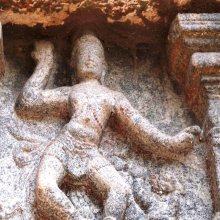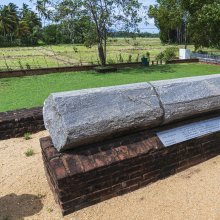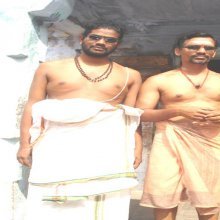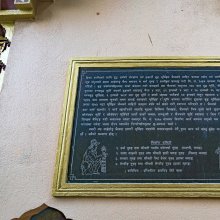Catura: 21 definitions
Introduction:
Catura means something in Hinduism, Sanskrit, Jainism, Prakrit, Buddhism, Pali, the history of ancient India, Marathi, Hindi. If you want to know the exact meaning, history, etymology or English translation of this term then check out the descriptions on this page. Add your comment or reference to a book if you want to contribute to this summary article.
Alternative spellings of this word include Chatura.
Images (photo gallery)
In Hinduism
Natyashastra (theatrics and dramaturgy)
Source: Wisdom Library: Nāṭya-śāstra1) Catura (चतुर).—One of the 108 karaṇas (minor dance movement) mentioned in the Nāṭyaśāstra chapter 4. The instructions for this catura-karaṇa is as follows, “the left hand with Añcita, (i.e., Alapallava) gesture, the right hand with Catura gesture, the right feet in Kuṭṭita (i.e. Udghaṭṭita) pose.”. A karaṇa represents a minor dance movements and combines sthāna (standing position), cārī (foot and leg movement) and nṛttahasta (hands in dancing position).
2) Catura (चतुर, “clever”) also refers to a specific gesture (āṅgika) made with the eyebrows (bhrū), according to the Nāṭyaśāstra chapter 8. These gestures of the eyelids (puṭa) are supposed to be performed in accordance with the corresponding gestures of the eyeballs (tārā) and the eyelids (puṭa). These gestures form a part of the histrionic representation (abhinaya).
(Instructions): slightly moving and excending (?) the eyebrows in a pleasing manner. (Uses): in love (śṛṅgāra), sportiveness (lalita), pleasing object (saumya), pleasing touch and awakening (sukhasparśa).
3) Catura (चतुर) also refers to a gesture (āṅgika) made with a ‘single hand’ (asaṃyuta), according to the Nāṭyaśāstra chapter 8. The hands (hasta) form a part of the human body which represents one of the six major limbs (aṅga) used in dramatic performance. With these limbs are made the various gestures (āṅgika), which form a part of the histrionic representation (abhinaya).
(Instructions): The four fingers stretched and the thumb bent near the middle finger. (Uses): It is to be applied in representing policy, discipline, penance, cleverness, a young girl, a sick person, perfidy, gambling, proper words, salutary truth, and tranquillity.
Source: archive.org: The mirror of gesture (abhinaya-darpana)1) One of six movements of the Brows: Catura: the brows meeting and faintly quivering. It is used in touching one another’s face, heart’s bliss, and excitement.
2) One of the Twenty-eight Single Hands (hasta):—Catura: the thumb is bent to touch the base of the third finger, the first and adjoining fingers outstretched together, and the little finger extended (separately). Usage: musk, a little,gold, copper etc., wet, sorrow, aesthetic emotion (rasāsvāda),eyes, difference of caste, oath, playful converse (sarasa), slowstepping,breaking to pieces, seat (āsana), oil or ghī, etc.
According to another book: in the Patāka hand, the thumb is made to touch the middle line of the third finger, and the Kttlefinger is stretched out. It originates from Kaśyapa, who usedthis hand to show the way to Garuḍa when he wished to steal thenectar. Its sage is Valakhilya, its colour variegated, its racemixed, its patron deity Vainateya. Usage: gorocana, dust, playful converse, red paint (laktaka), concentration of mind (or attention), camphor, eye, chin, earring, face, brow, side glance, beloved, policy, musk, sugar, honey, oil, ghī, cleverness, mirror, gold, diamond, emerald, sufiiciency, a little, a moderate quantityof anything, indigo, white colour, mixed caste, sword, cheek, tip of the ear.
Source: archive.org: Illustrations of Indian Music and Dance in Western Indian Style (natya)Catura (चतुर) refers to “expanding the eye-brows slightly up”, and is classified as one of the seven movements of the eye-brows, which forms a part of upāṅga (minor body-parts) in Nāṭyaśāstra. Catura can be used in amorous gestures, grace, calmness, touching.
Source: Shodhganga: Elements of Art and Architecture in the Trtiyakhanda of the Visnudharmottarapurana (natya)1) Catura (चतुर) refers to one of the twenty-two Asaṃyuktahastas or “single hand gestures” (in Indian Dramas), according to the Viṣṇudharmottarapurāṇa, an ancient Sanskrit text which (being encyclopedic in nature) deals with a variety of cultural topics such as arts, architecture, music, grammar and astronomy.—The hasta-mudrās (lit. “hand-gestures”) are very essential to denote some particular action or state in dancing and these mudrās are formed with the help of hands and fingers.—The Viṣṇudharmottarapurāṇa says that in catura-hasta, the middle finger of the hand remains vertical, the thumb should be kept in the middle and the rest of the fingers are stretched out. According to the Viṣṇudharmottarapurāṇa, some colours are pointed with this hand gesture. When the hand is raised in catura posture, it denotes white colour. When the hand moves in circular way and in semi-circular motion in catura-hasta, it denotes yellow and red colour respectively. In compacted form it shows blue colour. When the hand is kept in normal position with catura-hasta, it denotes black and the other remaining colours.
Instead of showing colours, in the Abhinayadarpaṇa the catura posture denotes some metals like gold, copper and iron. This posture also shows the application of some greasy substances like oil, ghee etc on the face.
2) Catura (चतुर) refers to one of the 108 kinds of Karaṇa (“coordination of precise movements of legs and hands”), according to the Viṣṇudharmottarapurāṇa.—Accordingly, karaṇas are the coordination of precise movements of legs and hands performed in a particular posture. The Nāṭyaśāstra also gives its view point in the same spirit. In the Viṣṇudharmottarapurāṇa, one hundred and eight kinds of karaṇas are accepted, e.g., Catura.

Natyashastra (नाट्यशास्त्र, nāṭyaśāstra) refers to both the ancient Indian tradition (shastra) of performing arts, (natya—theatrics, drama, dance, music), as well as the name of a Sanskrit work dealing with these subjects. It also teaches the rules for composing Dramatic plays (nataka), construction and performance of Theater, and Poetic works (kavya).
In Jainism
General definition (in Jainism)
Source: The University of Sydney: A study of the Twelve ReflectionsCaturā (चतुरा) refers to “skilful (examination)”, according to the 11th century Jñānārṇava, a treatise on Jain Yoga in roughly 2200 Sanskrit verses composed by Śubhacandra.—Accordingly, “A bad birth is hard to be accomplished even in a dream for him whose judgment, which is extremely skilful at examination (vicāra-caturā) like a door-keeper, shines in the mind. Having got rid of the multitude of imaginings, when the steady mind holds onto [its] nature, then it is indeed the best [form of] stopping the influx of karma for a mendicant”.

Jainism is an Indian religion of Dharma whose doctrine revolves around harmlessness (ahimsa) towards every living being. The two major branches (Digambara and Svetambara) of Jainism stimulate self-control (or, shramana, ‘self-reliance’) and spiritual development through a path of peace for the soul to progess to the ultimate goal.
India history and geography
Source: Cologne Digital Sanskrit Dictionaries: Indian Epigraphical GlossaryCatura.—cf. caturaka; a square. Note: catura is defined in the “Indian epigraphical glossary” as it can be found on ancient inscriptions commonly written in Sanskrit, Prakrit or Dravidian languages.

The history of India traces the identification of countries, villages, towns and other regions of India, as well as mythology, zoology, royal dynasties, rulers, tribes, local festivities and traditions and regional languages. Ancient India enjoyed religious freedom and encourages the path of Dharma, a concept common to Buddhism, Hinduism, and Jainism.
Languages of India and abroad
Pali-English dictionary
Source: BuddhaSasana: Concise Pali-English Dictionarycatura : (adj.) clever; skilled; shrewd.
Source: Sutta: The Pali Text Society's Pali-English DictionaryCatura, (Deriv. uncertain. Perhaps from tvar to move, that is quickly. Sk. catura) clever, skilled, shrewd J. III, 266; VI, 25.—Der. f. abstr. caturatā cleverness Vbh. 351 (=cāturiya). (Page 261)

Pali is the language of the Tipiṭaka, which is the sacred canon of Theravāda Buddhism and contains much of the Buddha’s speech. Closeley related to Sanskrit, both languages are used interchangeably between religions.
Marathi-English dictionary
Source: DDSA: The Molesworth Marathi and English Dictionarycatura (चतुर).—a (S) Shrewd, sagacious, intelligent, ingenious, clever.
--- OR ---
cātura (चातुर).—a (S Common in poetry and ballads.) Shrewd, sagacious, intelligent, ingenious, clever.
--- OR ---
cātūra (चातूर).—a (cātura S) Shrewd, sagacious &c.
Source: DDSA: The Aryabhusan school dictionary, Marathi-Englishcatura (चतुर).—a Shrewd, sagacious, intelligent, ingenious, clever.
--- OR ---
cātura (चातुर).—a Shrewd, clever.
Marathi is an Indo-European language having over 70 million native speakers people in (predominantly) Maharashtra India. Marathi, like many other Indo-Aryan languages, evolved from early forms of Prakrit, which itself is a subset of Sanskrit, one of the most ancient languages of the world.
Sanskrit dictionary
Source: DDSA: The practical Sanskrit-English dictionaryCatura (चतुर).—a. [cat-urac]
1) Clever, skilful, ingenious, sharp-witted; सर्वात्मना रतिकथाचतुरेव दूती (sarvātmanā ratikathācatureva dūtī) Mu.3.9; Amaruśataka 15.44; मृगया जहार चतुरेव कामिनी (mṛgayā jahāra catureva kāminī) R.9.69;18.15.
2) Quick, swift.
3) Charming, beautiful, lovely, agreeable; न पुनरेति गतं चतुरं वयः (na punareti gataṃ caturaṃ vayaḥ) R.9.47; Kumārasambhava 1.47; 3.5;5.49.
-raḥ 1 A round pillow.
2) Crooked gait.
3) An elephant's stable.
-ram 1 Cleverness, ingenuity.
2) An elephant's stable.
Source: Cologne Digital Sanskrit Dictionaries: Shabda-Sagara Sanskrit-English DictionaryCatura (चतुर).—mfn.
(-raḥ-rā-raṃ) 1. Dexterous, ingenious, clever. 2. Visible, perceptible. m.
(-raḥ) 1. A round pillow, one for the cheek. 3. An elephant stable. E. cat to ask, Unadi affix urac.
--- OR ---
Cātura (चातुर).—mfn.
(-raḥ-rī-raṃ) 1. Perceptible, visible. 2. Speaking well or amiably. 3. Driving, one who drives, a driver, a charioteer, &c. 4. Clever, able, ingenious. 5. Relating to four. f. (-rī) Dexterity, ability, cleverness. m.
(-raḥ) A small round pillow for resting the cheek upon. n.
(-raṃ) a four-wheeled carriage, a cart holding four people. E. catura dexterous, or catur four, aṇ affix; also with kan added cāturaka.
Source: Cologne Digital Sanskrit Dictionaries: Benfey Sanskrit-English DictionaryCatura (चतुर).—I. adj., f. rā. 1. Dexterous, [Pañcatantra] 161, 2. 2. Ingenious, [Pañcatantra] 158, 9. 3. Charming, [Raghuvaṃśa, (ed. Stenzler.)] 8, 94. 4. Quick, [Rājataraṅgiṇī] 3, 176; ºram, adv. 188. Ii. n. Cleverness, [Amaruśataka, (ed. Calcutt.)] 20.
Source: Cologne Digital Sanskrit Dictionaries: Cappeller Sanskrit-English DictionaryCatura (चतुर).—1. [adjective] swift, quick, dexterous, clever, skilful in (—°); [abstract] tā [feminine], tva [neuter]
--- OR ---
Catura (चतुर).—2. (—°) v. catvār.
Source: Cologne Digital Sanskrit Dictionaries: Monier-Williams Sanskrit-English Dictionary1) Catura (चतुर):—[from catasṛ] 1. catura mfn. ifc. = tur (cf. upaand tri-, [Pāṇini 5-4, 77], [vArttika]; a-,vi-,su-, [Vopadeva vi, 29])
2) 2. catura mf(ā cf. [gana] arśa-ādi)n. (√cat, [Uṇādi-sūtra]) swift, quick, [Kathāsaritsāgara x, 108; Rājataraṅgiṇī iii, 176]
3) dexterous, clever, ingenious, shrewd, [Raghuvaṃśa; Vikramorvaśī; Kumāra-sambhava; Pañcatantra] etc.
4) charming, agreeable, [Raghuvaṃśa; Bhartṛhari]
5) visible, [cf. Lexicographers, esp. such as amarasiṃha, halāyudha, hemacandra, etc.]
6) m. a round pillow (cf. cāt), [cf. Lexicographers, esp. such as amarasiṃha, halāyudha, hemacandra, etc.]
7) the fish Cyprinus Rohita, [Demetrius Galanos’s Lexiko: sanskritikes, anglikes, hellenikes]
8) ([scilicet] hasta) a particular position of the hand, [Purāṇa-sarvasva]
9) n. = -tā [gana] arśa-ādi
10) an elephant’s stable, [cf. Lexicographers, esp. such as amarasiṃha, halāyudha, hemacandra, etc.]
11) Cātura (चातुर):—1. cātura mfn. ([from] catur) drawn by 4 (a carriage), [Pāṇini 4-2, 92; Kāśikā-vṛtti]
12) 2. cātura mfn. ([from] 2. cat) clever, shrewd, [cf. Lexicographers, esp. such as amarasiṃha, halāyudha, hemacandra, etc.]
13) speaking kindly, flattering, [cf. Lexicographers, esp. such as amarasiṃha, halāyudha, hemacandra, etc.]
14) visible, [cf. Lexicographers, esp. such as amarasiṃha, halāyudha, hemacandra, etc.]
15) governing, [cf. Lexicographers, esp. such as amarasiṃha, halāyudha, hemacandra, etc.]
16) m. a small round pillow, [cf. Lexicographers, esp. such as amarasiṃha, halāyudha, hemacandra, etc.] (cf. galla-cāturī)
Source: Cologne Digital Sanskrit Dictionaries: Yates Sanskrit-English Dictionary1) Catura (चतुर):—[(raḥ-rā-raṃ) a.] Dexterous; perceptible. m. A round pillow, one for the cheek; elephant’s stable.
2) Cātura (चातुर):—[(raḥ-rā-raṃ) a.] Perceptible; speaking well; clever; driving of four. m. A small round pillow. f. Dexterity. n. A carriage or cart for four people.
Source: DDSA: Paia-sadda-mahannavo; a comprehensive Prakrit Hindi dictionary (S)Catura (चतुर) in the Sanskrit language is related to the Prakrit word: Caura.
[Sanskrit to German]
Sanskrit, also spelled संस्कृतम् (saṃskṛtam), is an ancient language of India commonly seen as the grandmother of the Indo-European language family (even English!). Closely allied with Prakrit and Pali, Sanskrit is more exhaustive in both grammar and terms and has the most extensive collection of literature in the world, greatly surpassing its sister-languages Greek and Latin.
Hindi dictionary
Source: DDSA: A practical Hindi-English dictionaryCatura (चतुर) [Also spelled chatur]:—(a) clever, shrewd; wise; skilful, skilled; ~[tā/pana] cleverness, shrewdness; wisdom; skill.
...
Kannada-English dictionary
Source: Alar: Kannada-English corpusCatura (ಚತುರ):—[adjective] = ಚತು [catu].
--- OR ---
Catura (ಚತುರ):—
1) [adjective] having or showing an alert mind or high intelligence; clever; intelligent; wise.
2) [adjective] characterised by much action or motion; lively, active, agile, quick.
3) [adjective] having ability; able to do things well; skilled; competent; capable.
--- OR ---
Catura (ಚತುರ):—
1) [noun] an intelligent, clever man.
2) [noun] a capable, competent man.
--- OR ---
Cātura (ಚಾತುರ):—
1) [adjective] skilful, talented; quick to understand or react.
2) [adjective] pleasing to the senses; pleasant; beautiful; enticing.
--- OR ---
Cātura (ಚಾತುರ):—
1) [noun] the quality of being ingenious; cleverness; ingenuity.
2) [noun] the act of speaking pleasing words (mainly to gratify another).
Kannada is a Dravidian language (as opposed to the Indo-European language family) mainly spoken in the southwestern region of India.
See also (Relevant definitions)
Starts with (+141): Catura-aghata-vishuddha, Caturabdhi, Caturabha, Caturabhava, Caturacam, Caturaccakkaram, Caturaccanti, Caturacudamani, Caturadhipati, Caturadhitthana, Caturadhyayi, Caturadhyayika, Caturadhyayika shaunakiya, Caturaga, Caturaghata, Caturagnivant, Caturagnivat, Caturahan, Caturahara, Caturahasta.
Ends with (+4): Acatura, Ardha-catura, Aticatura, Avadacatura, Didacatura, Didhacatura, Kacatura, Khanda-catura, Kriyacatura, Laukikacatura, Lilacatura, Padacatura, Prapancacatura, Prayogacatura, Priyacatura, Samayacatura, Sucatura, Tricatura, Upacatura, Vacanacatura.
Full-text (+144): Caturaka, Caturika, Caturata, Upacatura, Acatura, Tricatura, Upacaturam, Prapancacatura, Lilacatura, Vishvasasthana, Catula, Camacaturam, Caturaga, Caturakrama, Acaturam, Caturatva, Tirkkacaturam, Caturbhuji, Dvitricaturam, Caturyacintamani.
Relevant text
Search found 27 books and stories containing Catura, Cātura, Cātūra; (plurals include: Caturas, Cāturas, Cātūras). You can also click to the full overview containing English textual excerpts. Below are direct links for the most relevant articles:
Rig Veda (translation and commentary) (by H. H. Wilson)
Sahitya-kaumudi by Baladeva Vidyabhushana (by Gaurapada Dāsa)
Text 10.52 < [Chapter 10 - Ornaments of Meaning]
Bhakti-rasamrta-sindhu (by Śrīla Rūpa Gosvāmī)
Verse 3.3.44 < [Part 3 - Fraternal Devotion (sakhya-rasa)]
Verse 2.1.86 < [Part 1 - Ecstatic Excitants (vibhāva)]
Verse 2.4.57 < [Part 4 - Transient Ecstatic Disturbances (vyābhicāri-bhāva)]
Abhinaya-darpana (English) (by Ananda Coomaraswamy)
Chapter 25 - Hands denoting Trees
Chapter 23 - Hands denoting Famous Rivers
Kavyamimamsa of Rajasekhara (Study) (by Debabrata Barai)
Part 9 - Rājaśekhara’s association with Gujarāta (Gujarat) < [Chapter 1 - Introduction]
Manusmriti with the Commentary of Medhatithi (by Ganganatha Jha)
Verse 11.219 < [Section XXIX - Description of the Expiatory Penances]
Verse 9.304 < [Section XL - Personal Behaviour of the King]
Verse 3.268 < [Section XXI - Relative Merits of the Offering-Materials]



